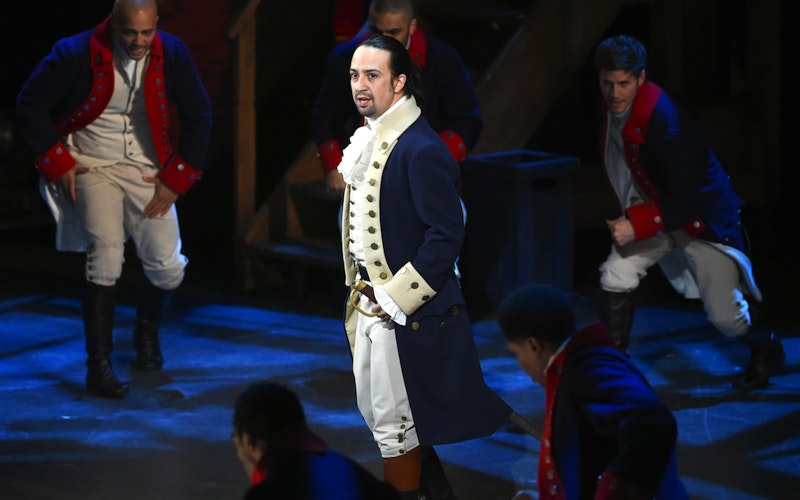
Culture At Large
Hamilton and the Diversity of God's Kingdom
When I say that the hit musical Hamilton is a work of art, know that I say it as a voracious lover of musical theater. And when I say that Lin-Manuel Miranda’s Broadway phenomenon, now playing in Chicago, will be a precedent for the artistic community, know that I say this with both hope and lamentation. Something as important as Hamilton—which casts many people of color in a tale of early American history—has been a long time coming. And it feels a bit like Kingdom come.
Hamilton was in the news again over the weekend, as Vice President-elect Mike Pence attended a Friday performance. As the show ended, actor Brandon Victor Dixon read the following statement to Pence: “We, sir—we—are the diverse America who are alarmed and anxious that your new administration will not protect us, our planet, our children, our parents, or defend us and uphold our inalienable rights. But we truly hope that this show has inspired you to uphold our American values and to work on behalf of all of us. All of us.” This was a living, breathing example of the stage not being a stage, of art reflecting life.
When I saw Hamilton earlier this fall, I experienced it differently than Pence. Imagine spending years working in a particular field and rarely seeing anyone who looked like you—especially in a leadership position. Imagine sitting in rooms at work and being one of the only people of color. And then imagine walking into one of the most dazzling theaters in Chicago and being taken aback by a cast of so many races—including your own—and by an entire production whose music, imagery, references, and style all incorporated your culture, your passions, your skin. Imagine the joy you would feel at seeing so many people who look and sound like you happy, singing, rapping—and being paid to do so. Now imagine that most of the country was praising the effort (including Pence, who reportedly "applauded after most of [the] numbers").
As a black man who has spent the past 15 years deeply entrenched in the artistic community of one of America’s most diverse—and segregated—cities, I know that art reflects life. The majority of Chicago’s residents are nonwhite and most of them are structurally or culturally locked out of employment, housing, and artistic circles. Many people across America are producing art, but only certain ones (often reflected by the color of their skin) are paid well and promoted to do so. Thus I am hopeful for what I have seen with Hamilton—a diverse Broadway success created by a man of Puerto Rican descent—even if I still lament that it is such a rarity.
The sad reality is that much of American life—be it in Hollywood, the video gaming space, or tech culture—still struggles to achieve genuine diversity. Often, it only means silent presence. Hamilton forces us to ask: what is the value of diversity—in the world and within the Kingdom? Can art be a form of justice and a platform for a radically inclusive paradigm shift?
I am hopeful for what I have seen with Hamilton, even if I still lament that it is such a rarity.
By demonstrating that a Founding Father of the United States could be represented by anyone, including people of color, Lin-Manuel Miranda has created a work of art as diverse as the Kingdom of God described in Revelation. Christians should embrace Hamilton as a model for reconciliation and representation moving forward. Not just because there are people of color in the production (diversity), but because people of color produced and are reaping the benefits of its excellence (inclusion). That inclusion and source of ownership is a form of justice that betters the world.
In 1 Corinthians 9, Paul lays out a challenging concept: that his adaptation to those around him is a tool for God’s Kingdom. His willingness to serve others by learning to respect them enough to speak to them in their language, eat their food, and submit to their customs only strengthens his ministry. He knew that he could not speak to the heart of people if he shunned their very identity. This did not mean he took up unholy acts, but that he took the time to love them enough to respect them—rather than just fear for them and seek their conversion.
Paul, in other words, had privilege. Spiritual privilege. And that creates within him power. That power, used in a Godly manner, creates an immediate responsibility: to be strategic in his servanthood so that he doesn’t become haughty or proud, but rather the greatest servant God calls him to be. That requires a strategic application of his privilege, and so he embraces diversity in order to spread the Gospel.
Hamilton was produced by a Puerto Rican man who saw diversity as a priority—from the start. Those wealthier persons who helped fund and launch Hamilton were OK moving out of the way for Miranda to lead, not just perform or consult. That is not how those in privileged positions often begin their work, in my experience. Instead, non-minorities often begin by focusing on diversity as a nice extra—like charity. For the non-minority church and all those who stand on platforms of privilege, inclusion will need to be a strategic goal if we are going to achieve reconciliation—with each other and with God.
When a brown-skinned George Washington walks on stage and raps to a Latino Alexander Hamilton, know that a good work is happening, that minds will change, that hearts will soften. And know that this stage may be art imitating the Kingdom life we one day will live out together.
Topics: Culture At Large